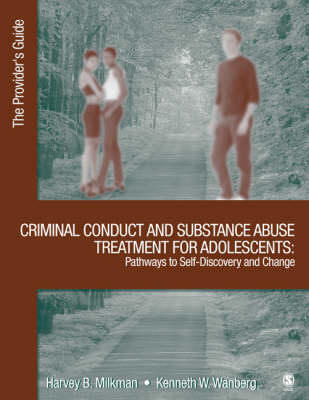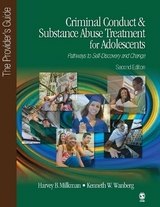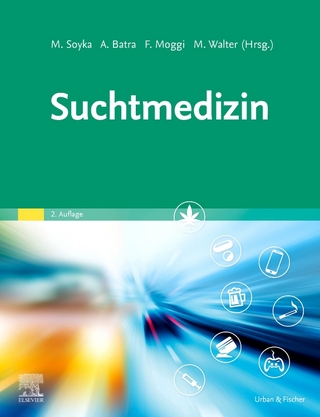
Criminal Conduct and Substance Abuse Treatment for Adolescents
SAGE Publications Inc (Verlag)
978-1-4129-0615-9 (ISBN)
- Titel erscheint in neuer Auflage
- Artikel merken
'Milkman and Wanberg's program rests upon the best that science has to offer. Once this workbook stimulates change, it pays attention to the principles of relapse prevention that will help young people stay changed - and this is the litmus test for any treatment program that targets behavioral problems.' -- Dr. Howard J. Shaffer, Ph.D., C.A.S. , Director &BAD:amp; Associate Professor, Division on Addictions, Harvard Medical School Psychology of Addictive Behaviors 'Pathways to Self-Discovery and Change is the most comprehensive and thoughtful program we have seen to help at-risk youth gain freedom from crime and drugs and develop attitudes and skills to lead productive prosocial lives.' -- G. Alan Marlatt, Ph.D. and George A. Parks, Ph.D. , Addictive Behaviors Research Center, University of Washington 'This exceptional and widely needed program shows great promise as a developmentally appropriate treatment model for adolescents who manifest co-occurring disturbances with substance abuse and criminal activity.It is uniquely designed to interest and engage high-risk teenagers in a thoughtful array of cognitive-behavioral restructuring exercises that are geared to promote fulfilling and responsible life choices.
' -- Lloyd I. Sederer, MD, Formerly Director of Clinical Services, American Psychiatric Association, and Medical Director , McLean Hospital/Harvard Medical SchoolTHE PROVIDERA S GUIDE (Criminal Conduct and Substance Abuse Treatment for Adolescents) identifies psychological, biological, and social factors that contribute to the onset of adolescent deviance, including substance abuse, delinquency, and crime. Causal models for these problem behaviors are described, followed by a review of assessment and treatment protocols widely used in contemporary practice. Guidelines are provided for delivery of the 32- session PSD-C treatment curriculum, specifically designed for adolescents who manifest co-existing juvenile justice and substance abuse problems.The PSD-C ProviderA s Guide explains how effective adolescent treatment derives from integration of the following evidence-based: strategies: motivational enhancement; stages of change; gender and diversity proficiency; cognitive-behavioral skill development; relapse and recidivism prevention; differential assessment; and individualized treatment planning.
The ProviderA s Guide delineates principles for effective adolescent-focused treatment in tandem with the ParticipantA s Workbook: Pathways to Self-Discovery and Change (PSD-C).
Kenneth W. Wanberg, ThD, PhD, has academic concentrations in biology, mathematics, clinical psychology, psychology of religion, psychometrics, quantitative analysis, and interpersonal communication and the psychology of spoken language. He worked as a counselor and clinical psychologist with the Division of Youth Corrections, State of Colorado for 17 years. He has been doing clinical work for 50 years and has had a private practice for 40 years. He has worked as a clinician and researcher in the field of alcohol and drug abuse for over 40 years and in the field of criminal conduct and substance abuse for over 25 years. Harvey B. Milkman, PhD received his baccalaureate degree from City College of New York and his doctorate from Michigan State University. He is currently professor of psychology at Metropolitan State College of Denver. His doctoral research was conducted with William Frosch, MD, at Bellevue Psychiatric Hospital in New York City, on the User's Drug of Choice. From 1980-1981, he completed a sabbatical exploration of addictive behavior in Africa, India, and Southeast Asia; in 1985 he was recipient of a Fulbright-Hays Lectureship award at the National University of Malaysia. He has represented the United States Information Agency as a consultant and featured speaker in Australia, Brazil, Iceland, The Netherlands, Peru, Turkey, and Yugoslavia. He is principle author with Stanley Sunderwirth of "The Chemistry of Craving," and author of "Better than Dope," featured articles in Psychology Today, October, 1983 and April, 2001 respectively. From September 1992-June 2002, he was author, principal investigator, and director of Project Self-Discovery: Artistic Alternatives for High-Risk Youth, a national demonstration model funded by The Center for Substance Abuse Prevention and the Edward Byrne Foundation.
Introduction: Promoting Adolescent Resiliency SECTION 1: THEORETICAL AND RESEARCH PERSPECTIVES Chapter 1: Risk and Resiliency During Adolescence The Experience of Adolescence Scope of Adolescent Problem Behavior Problem Behavior Theory The Offset of Risk and Resiliency in Adolescent Adjustment Summary of Risk Factors for Delinquency and Substance Abuse in Adolescents Empirical Studies of Resiliency A Strengths-Based Approach to Juvenile Justice and Treatment Services Chapter Review Chapter 2: Mental Health and Adolescent Problem Behavior The Scope of Adolescent Mental Health Issues Disruptive Behavior Disorders and Diagnostic Criteria Personality Disorders Post Traumatic Stress Disorder The MMPI-A: Use for Diagnosis and Treatment Planning Psychotheraputic Medications for Children and Adolescents Chapter Review Chapter 3: Substance Abuse and Adolescent Problem Behavior The Scope of Adolescent Substance Abuse Imminent Drug Threats Factors Associated with the Onset of Adolescent Substance Abuse Adolescent Drinking and Driving Relationship of Age to Adolescent AOD Abuse and Disruption Adolescent Drug Use and Criminal Conduct AOD Abuse Across American Subcultures Chapter Review Chapter 4: Substance Abuse and the Adolescent Brain The Human Brain: A Fast Idiot The Adolescent Brain Alcohol Methamphetamine: Need a Sudafed? Cocaine: "Gift of the Gods" Marijuana: Reefer Madness Revisited Opiates: Everyone Makes Them Ecstasy: Let's Party Inhalants: How Stupid Can You Get? Hallucinogenic Drugs: Chemical Vision Tobacco: The Ultimate Drug Chapter Review Chapter 5: Delinquency Crime and Violence Characteristics of Juvenile Delinquency Adolescence and Deviant Subculture Correlates of Juvenile Delinquency and Crime Theories of Adolescent Crime Developmental Aspects of Adolescent Crime Transient versus Stable Patterns of Delinquency and Crime Trends in Juvenile Violence Implications for Treatment and Policy Chapter Review Chapter 6: Gender and Adolescent Problem Behavior Adolescent Girls and Delinquency The Nature of Female Offense Gender Comparisons Across Risk and Drug Involvement Risk Factors and Correlates of Juvenile Offending Among Females Gender Norms and Sexual Violation Sexual Assault During Childhood Experiences with Violent Trauma in Childhood: A Major Route for Girls into Criminal Conduct Female Gang Participation Trauma Within the Juvenile Justice System Implications for Treatment and Policy: A Gender-Focused Treatment Platform Chapter Review Chapter 7: Youth Culture and Diversity Defining Culture and the Importance of Cultural Awareness Adolescent Subcultures Cultural Competencies Chapter Review Chapter 8: Perspectives on the Assessment Overview Objectives of Screening and Assessment The Structure and Content of Assessment: Data Sources and Report Subjectivity Valuing Client Self-Disclosure When Discerning the "True Picture" Convergent Validation and the Processes Model of Assessment Self-Report as a Valid Estimate of the "True" Condition Guidelines for Using Psychometric Assessment Instruments Determining Inclusion into a Substance Abuse Category The Process and Structure of Assessment Special Focus Areas for Juvenile Justice System Clients Chapter Review SECTION II THE TREATMENT PLATFORM FOR ADOLESCENT SERVICE DELIVERY Chapter 9: Foundations of Cognitive-Behavioral Therapy Historical Roots of Cognitive-Behavioral Therapy Contemporary CBT: Integrating Cognitive and Behavioral Principles and Approaches Underlying Principles of Cognitive-Behavioral Therapy Therapeutic Focal Points in CBT What Works in Psychotherapy: Empirical Support for the Use of CBT Chapter Review Chapter 10: Core Strategies for Delinquency, Crime and Substance Abuse Integrating Education and Therapy in the CBT Model Seven Core Strategies in the Education and Treatment Process Chapter Review Chapter 11: Cognitive-Behavioral Perspectives on Adolescent Treatment Treatment Efficacy with Juvenile Justice Clients: Past and Present Evidence for a Cognitive-Behavioral Approach to Adolescent Treatment Key Features of Cognitive-Behavioral Treatment for Adolescents Summary of Cognitive-Behavioral Principles Targeted at Delinquency, Crime and Substance Abuse Chapter Review Chapter 12: Treatment Systems and Modalities Individual Approaches to Treatment Family Systems Theory and Family Therapy Residential Treatment Chapter Review Chapter 13: Exemplary Treatment Programs Exemplary Youth Treatment Programs Nationally Recognized Programs Chapter Review SECTION III: PROGRAM IMPLEMENTATION Chapter 14: Operational Guidelines and Procedures for Program Delivery Overview Characteristics of the Effective Youth Corrections Counselor The Process and Structure of Program Delivery Ethical and Legal Considerations in Screening and Assessment Client Participation Guidelines and Ground Rules Program Structure and Delivery Guidelines Intake and Admission Methods and Procedures Principles of Effective Group Management and Leadership Operational Model for Assessment Chapter Review Chapter 15: The Treatment Curriculum Initiation of Treatment Cognitive-Behavioral Skill Development: Commitment to Change Cementing Gains: Ownership of Change: Skills for Self-Management, Responsible Living and Change Getting Started Curriculum Description Chapter Review Appendix A Referral Evaluation Summary (RES) Intake Personal Data Form Consent for Release of Confidential Information Client Rights Statement Consent for Program Involvement Health Insurance Portability and Accountability (HIPPA) Parent Consent Form Full Disclosure Statement Sample Notice of Federal Requirements Regarding Confidentiality Appendix B Substance Use Survey (SUS) Scoring Guide for Substance Use Survey (SUS) Adolescent Self-Assessment Questionnaire Social Response Questionnaire (SRQ) Scoring Guide and Scale Interpretation for SRQ References
| Erscheint lt. Verlag | 18.1.2005 |
|---|---|
| Zusatzinfo | Illustrations |
| Verlagsort | Thousand Oaks |
| Sprache | englisch |
| Maße | 216 x 280 mm |
| Themenwelt | Geisteswissenschaften ► Psychologie |
| Medizin / Pharmazie ► Medizinische Fachgebiete ► Suchtkrankheiten | |
| Recht / Steuern ► Strafrecht ► Kriminologie | |
| ISBN-10 | 1-4129-0615-6 / 1412906156 |
| ISBN-13 | 978-1-4129-0615-9 / 9781412906159 |
| Zustand | Neuware |
| Haben Sie eine Frage zum Produkt? |
aus dem Bereich



